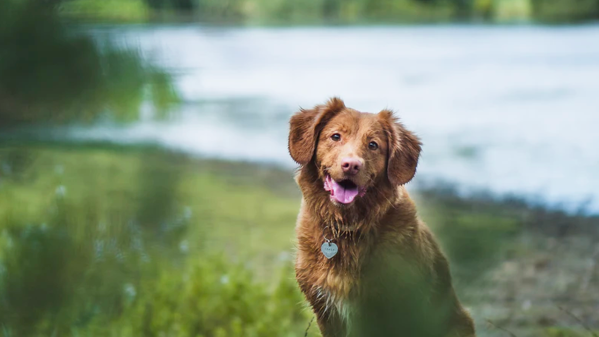As we get into the warmer months of the year, it may seem like a fun idea to go hiking with your pup, and maybe even let them play or swim at a local lake or pond. While taking a dip with your canine can have benefits, what's potentially lurking in that water can pose great risks to their health.
Once you reach the lake at the end of the trail, you may notice that the water appears cloudy or murky—or maybe it's a weird green color. If this is the case, you could be dealing with blue-green algae, and this can be extremely dangerous.
We spoke to vets and pet experts about algae poisoning in dogs (more specifically, blue-green algae) and its causes, symptoms, and potential treatments.
What is algae poisoning in dogs?
Blue-green algae is usually what we’re talking about when we think about algae poisoning in dogs. This is most often found in exactly the areas where dogs would most want to enjoy the sun and the tropical environment—but it’s a silent killer.
Is blue-green algae toxic to dogs?
The most common toxic algae in the U.S. is blue-green algae (cyanobacteria), and it's most likely to thrive in bodies of fresh water when the weather is warm and sunny. This algae releases dangerous toxins into the water that can be deadly to dogs and humans. It can cause everything from neurologic to liver damage that progresses rapidly.
Algae intoxications happen more during the summer because weather conditions promote the growth of cyanobacteria. Ultimately, these organisms are incredibly toxic and are known to cause poisoning in dogs, cats, livestock, wildlife, birds, fish and even humans.
How can you spot blue-green algae?
Blue-green algae may appear to look like spilled paint in water, thick foam on the surface, or swirls of color just on the surface of the water. It's important to check the appearance of the water before jumping in or letting your dog enter any natural water source.
While blue-green algae tends to form near the shoreline of lakes, the blooms can move around the lake depending on the wind, so be sure to check your swimming spot thoroughly before entering the water.
Causes of algae poisoning in dogs
It’s exactly what we love most about our dogs that puts them at risk when it comes to algae. Dogs are curious and playful, and they may go for a swim or taste the toxic water from the lake. That’s all it takes. Drinking the wrong water can lead to algae poisoning.
Dogs can be affected by the algae when they drink from contaminated water sources. Dogs that swim in contaminated water are at a higher risk of algae poisoning because of the amount of water they are likely to ingest. If toxic algae is ingested, it can cause severe neurologic or liver damage and lead to death.
When in doubt, stay away. Avoid water that seems at all out of the ordinary or like it could even potentially be risky. It’s not worth the risk, and the results could very well be tragic.
Signs of algae poisoning in dogs
If you have just been to a pond or a lake and you notice a change in behavior in your dog, it's important to talk to a vet to understand if algae poisoning could be the cause.
Signs of algae poisoning in dogs include:
If your dog is displaying any of the above behaviors or symptoms, you should get them to a vet immediately.
The vet will have to work quickly if your dog has a chance of recovering. Prevention is your best bet with algae poisoning.
How to treat algae poisoning in dogs
If you think your dog has come in contact with toxic algae, get out of the water. The bacteria is very dangerous for humans as well as pets. Immediately try to rinse yourself and your dog with fresh water and get to your vet right away.
Do not wait and just monitor symptoms, especially if you think your dog may have ingested water with the algae. The symptoms can arise quickly, and with the toxicity, your dog’s health can spiral quickly.
How to prevent algae poisoning in dogs
Ultimately, the best way to help your dog is going to be through prevention. Do not let your dogs drink, swim, or play near water that has algae or looks murky or cloudy in any way.
Professional medical assistance will ensure that your dog receives the right type of treatment for their condition quickly, and speed is crucial in treating algae poisoning because algal toxins act fast. Your dog may take weeks or even months to recover from algae poisoning.
Treatment may include inducing vomiting to get algae out or administering activated charcoal early to absorb some of the toxin. There is no specific antidote, so treatment is limited to supportive care. IV fluids usually are administered and sometimes muscle relaxers or anti-seizure medications.
Algae poisoning in dogs can be very deadly. The best way to help your dog is to block access to blue-green algae. This means fencing off contaminated ponds, lakes, and fountains when possible, and not letting them swim or be around it. Even if they swim in it and don't drink it, they could lick it off of their fur later and get sick.
If you think your dog may have come into contact with blue-green algae, reach out to the experts at Pawp—we're here to help 24/7.
